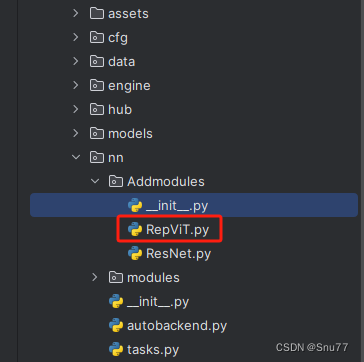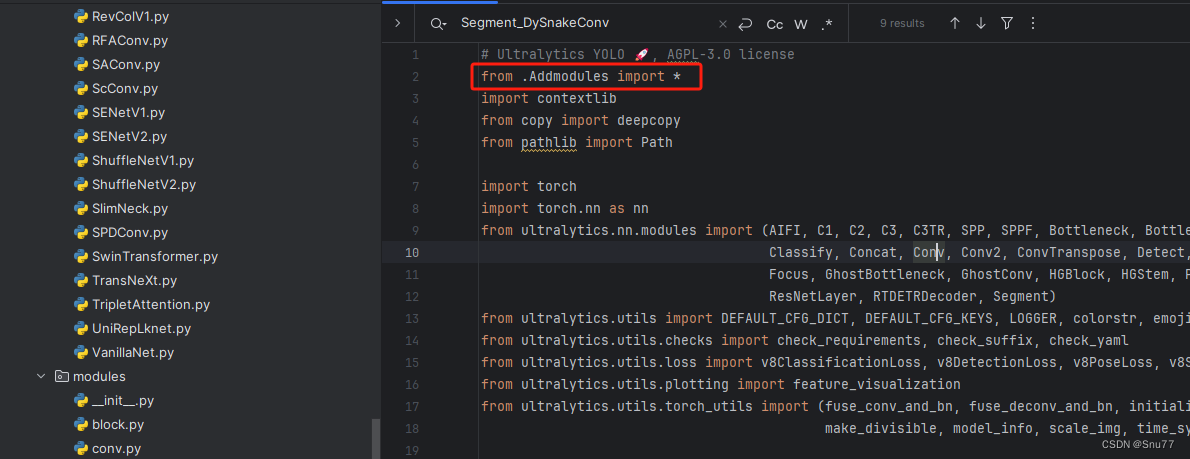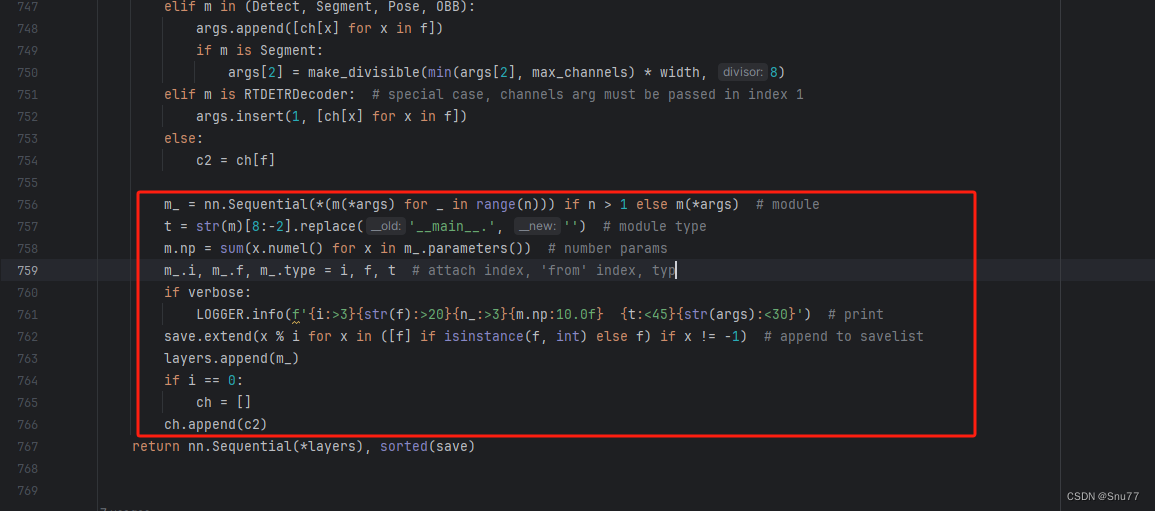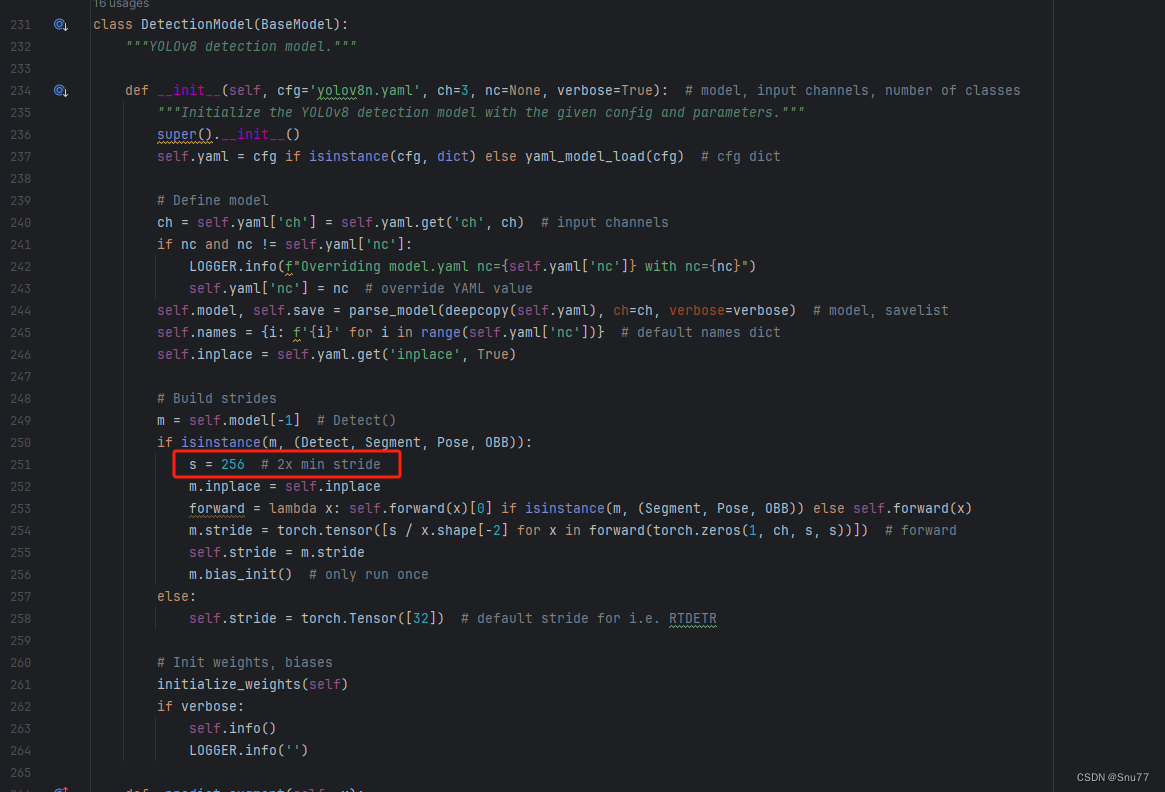前言
大家好,我是Snu77,这里是RT-DETR有效涨点专栏。
本专栏的内容为根据ultralytics版本的RT-DETR进行改进,内容持续更新,每周更新文章数量3-10篇。
专栏以ResNet18、ResNet50为基础修改版本,同时修改内容也支持ResNet32、ResNet101和PPHGNet版本,其中ResNet为RT-DETR官方版本1:1移植过来的,参数量基本保持一致(误差很小很小),不同于ultralytics仓库版本的ResNet官方版本,同时ultralytics仓库的一些参数是和RT-DETR相冲的所以我也是会教大家调好一些参数,真正意义上的跑ultralytics的和RT-DETR官方版本的无区别
👑欢迎大家订阅本专栏,一起学习RT-DETR👑
一、本文介绍
本位给大家带来的改进机制是RepViT。它是一种最新发布的网络结构,把轻量级的视觉变换器(就是ViT)的设计理念融入到了我们常用的轻量级卷积神经网络(CNN)里。我尝试把它用在RT-DETR的主干网络上,效果还不错,mAP有一定的提高。我用的是这个网络中最轻量级的版本。 我将其用于在我的数据上实验(包含多个类别其中包含大中小多个目标类别),无论哪种目标,精度均有所提升。接下来,我会展示一下原始版本和我改进后版本在训练上的对比图。之后会在文章中介绍该网络结构,然后教大家如何修改该网络结构,同时修改该主干参数量下降四分之一相对于ResNet18。

专栏链接:RT-DETR剑指论文专栏,持续复现各种顶会内容——论文收割机RT-DETR
目录
一、本文介绍
三、RepViT的核心代码
四、手把手教你添加RepViT网络结构
4.1 修改一
4.2 修改二
4.3 修改三
4.4 修改四
4.5 修改五
4.6 修改六
4.7 修改七
4.8 修改八
4.9 RT-DETR不能打印计算量问题的解决
4.10 可选修改
五、RepViT的yaml文件
5.1 yaml文件
5.2 运行文件
5.3 成功训练截图
六、全文总结
二、RepViT基本原理

官方论文地址: 官方论文地址点击即可跳转
官方代码地址: 官方代码地址点击即可跳转

RepViT: Revisiting Mobile CNN From ViT Perspective 这篇论文探讨了如何改进轻量级卷积神经网络(CNN)以提高其在移动设备上的性能和效率。作者们发现,虽然轻量级视觉变换器(ViT)因其能够学习全局表示而表现出色,但轻量级CNN和轻量级ViT之间的架构差异尚未得到充分研究。因此,他们通过整合轻量级ViT的高效架构设计,逐步改进标准轻量级CNN(特别是MobileNetV3),从而创造了一系列全新的纯CNN模型,称为RepViT。这些模型在各种视觉任务上表现出色,比现有的轻量级ViT更高效。
其主要的改进机制包括:
-
结构性重组:通过结构性重组(Structural Re-parameterization, SR),引入多分支拓扑结构,以提高训练时的性能。
-
扩展比率调整:调整卷积层中的扩展比率,以减少参数冗余和延迟,同时提高网络宽度以增强模型性能。
-
宏观设计优化:对网络的宏观架构进行优化,包括早期卷积层的设计、更深的下采样层、简化的分类器,以及整体阶段比例的调整。
-
微观设计调整:在微观架构层面进行优化,包括卷积核大小的选择和压缩激励(SE)层的最佳放置。
这些创新机制共同推动了轻量级CNN的性能和效率,使其更适合在移动设备上使用,下面的是官方论文中的结构图,我们对其进行简单的分析。

这张图片是论文中的图3,展示了RepViT架构的总览。RepViT有四个阶段,输入图像的分辨率依次为

每个阶段的通道维度用 Ci 表示,批处理大小用 B 表示。
- Stem:用于预处理输入图像的模块。
- Stage1-4:每个阶段由多个RepViTBlock组成,以及一个可选的RepViTSEBlock,包含深度可分离卷积(3x3DW),1x1卷积,压缩激励模块(SE)和前馈网络(FFN)。每个阶段通过下采样减少空间维度。
- Pooling:全局平均池化层,用于减少特征图的空间维度。
- FC:全连接层,用于最终的类别预测。
总结:大家可以将RepViT看成是MobileNet系列的改进版本
三、RepViT的核心代码
下面的代码是整个RepViT的核心代码,其中有多个版本,对应的GFLOPs也不相同,使用方式看章节四。
import torch.nn as nn
from timm.models.layers import SqueezeExcite
import torch__all__ = ['repvit_m0_6','repvit_m0_9', 'repvit_m1_0', 'repvit_m1_1', 'repvit_m1_5', 'repvit_m2_3']def _make_divisible(v, divisor, min_value=None):"""This function is taken from the original tf repo.It ensures that all layers have a channel number that is divisible by 8It can be seen here:https://github.com/tensorflow/models/blob/master/research/slim/nets/mobilenet/mobilenet.py:param v::param divisor::param min_value::return:"""if min_value is None:min_value = divisornew_v = max(min_value, int(v + divisor / 2) // divisor * divisor)# Make sure that round down does not go down by more than 10%.if new_v < 0.9 * v:new_v += divisorreturn new_vclass Conv2d_BN(torch.nn.Sequential):def __init__(self, a, b, ks=1, stride=1, pad=0, dilation=1,groups=1, bn_weight_init=1, resolution=-10000):super().__init__()self.add_module('c', torch.nn.Conv2d(a, b, ks, stride, pad, dilation, groups, bias=False))self.add_module('bn', torch.nn.BatchNorm2d(b))torch.nn.init.constant_(self.bn.weight, bn_weight_init)torch.nn.init.constant_(self.bn.bias, 0)@torch.no_grad()def fuse_self(self):c, bn = self._modules.values()w = bn.weight / (bn.running_var + bn.eps) ** 0.5w = c.weight * w[:, None, None, None]b = bn.bias - bn.running_mean * bn.weight / \(bn.running_var + bn.eps) ** 0.5m = torch.nn.Conv2d(w.size(1) * self.c.groups, w.size(0), w.shape[2:], stride=self.c.stride, padding=self.c.padding, dilation=self.c.dilation,groups=self.c.groups,device=c.weight.device)m.weight.data.copy_(w)m.bias.data.copy_(b)return mclass Residual(torch.nn.Module):def __init__(self, m, drop=0.):super().__init__()self.m = mself.drop = dropdef forward(self, x):if self.training and self.drop > 0:return x + self.m(x) * torch.rand(x.size(0), 1, 1, 1,device=x.device).ge_(self.drop).div(1 - self.drop).detach()else:return x + self.m(x)@torch.no_grad()def fuse_self(self):if isinstance(self.m, Conv2d_BN):m = self.m.fuse_self()assert (m.groups == m.in_channels)identity = torch.ones(m.weight.shape[0], m.weight.shape[1], 1, 1)identity = torch.nn.functional.pad(identity, [1, 1, 1, 1])m.weight += identity.to(m.weight.device)return melif isinstance(self.m, torch.nn.Conv2d):m = self.massert (m.groups != m.in_channels)identity = torch.ones(m.weight.shape[0], m.weight.shape[1], 1, 1)identity = torch.nn.functional.pad(identity, [1, 1, 1, 1])m.weight += identity.to(m.weight.device)return melse:return selfclass RepVGGDW(torch.nn.Module):def __init__(self, ed) -> None:super().__init__()self.conv = Conv2d_BN(ed, ed, 3, 1, 1, groups=ed)self.conv1 = torch.nn.Conv2d(ed, ed, 1, 1, 0, groups=ed)self.dim = edself.bn = torch.nn.BatchNorm2d(ed)def forward(self, x):return self.bn((self.conv(x) + self.conv1(x)) + x)@torch.no_grad()def fuse_self(self):conv = self.conv.fuse_self()conv1 = self.conv1conv_w = conv.weightconv_b = conv.biasconv1_w = conv1.weightconv1_b = conv1.biasconv1_w = torch.nn.functional.pad(conv1_w, [1, 1, 1, 1])identity = torch.nn.functional.pad(torch.ones(conv1_w.shape[0], conv1_w.shape[1], 1, 1, device=conv1_w.device),[1, 1, 1, 1])final_conv_w = conv_w + conv1_w + identityfinal_conv_b = conv_b + conv1_bconv.weight.data.copy_(final_conv_w)conv.bias.data.copy_(final_conv_b)bn = self.bnw = bn.weight / (bn.running_var + bn.eps) ** 0.5w = conv.weight * w[:, None, None, None]b = bn.bias + (conv.bias - bn.running_mean) * bn.weight / \(bn.running_var + bn.eps) ** 0.5conv.weight.data.copy_(w)conv.bias.data.copy_(b)return convclass RepViTBlock(nn.Module):def __init__(self, inp, hidden_dim, oup, kernel_size, stride, use_se, use_hs):super(RepViTBlock, self).__init__()assert stride in [1, 2]self.identity = stride == 1 and inp == oupassert (hidden_dim == 2 * inp)if stride == 2:self.token_mixer = nn.Sequential(Conv2d_BN(inp, inp, kernel_size, stride, (kernel_size - 1) // 2, groups=inp),SqueezeExcite(inp, 0.25) if use_se else nn.Identity(),Conv2d_BN(inp, oup, ks=1, stride=1, pad=0))self.channel_mixer = Residual(nn.Sequential(# pwConv2d_BN(oup, 2 * oup, 1, 1, 0),nn.GELU() if use_hs else nn.GELU(),# pw-linearConv2d_BN(2 * oup, oup, 1, 1, 0, bn_weight_init=0),))else:assert (self.identity)self.token_mixer = nn.Sequential(RepVGGDW(inp),SqueezeExcite(inp, 0.25) if use_se else nn.Identity(),)self.channel_mixer = Residual(nn.Sequential(# pwConv2d_BN(inp, hidden_dim, 1, 1, 0),nn.GELU() if use_hs else nn.GELU(),# pw-linearConv2d_BN(hidden_dim, oup, 1, 1, 0, bn_weight_init=0),))def forward(self, x):return self.channel_mixer(self.token_mixer(x))class RepViT(nn.Module):def __init__(self, cfgs):super(RepViT, self).__init__()# setting of inverted residual blocksself.cfgs = cfgs# building first layerinput_channel = self.cfgs[0][2]patch_embed = torch.nn.Sequential(Conv2d_BN(3, input_channel // 2, 3, 2, 1), torch.nn.GELU(),Conv2d_BN(input_channel // 2, input_channel, 3, 2, 1))layers = [patch_embed]# building inverted residual blocksblock = RepViTBlockfor k, t, c, use_se, use_hs, s in self.cfgs:output_channel = _make_divisible(c, 8)exp_size = _make_divisible(input_channel * t, 8)layers.append(block(input_channel, exp_size, output_channel, k, s, use_se, use_hs))input_channel = output_channelself.features = nn.ModuleList(layers)self.width_list = [i.size(1) for i in self.forward(torch.randn(1, 3, 640, 640))]def forward(self, x):# x = self.features(xresults = [None, None, None, None]temp = Nonei = Nonefor index, f in enumerate(self.features):x = f(x)if index == 0:temp = x.size(1)i = 0elif x.size(1) == temp:results[i] = xelse:temp = x.size(1)i = i + 1return resultsdef repvit_m0_6():"""Constructs a MobileNetV3-Large model"""cfgs = [[3, 2, 40, 1, 0, 1],[3, 2, 40, 0, 0, 1],[3, 2, 80, 0, 0, 2],[3, 2, 80, 1, 0, 1],[3, 2, 80, 0, 0, 1],[3, 2, 160, 0, 1, 2],[3, 2, 160, 1, 1, 1],[3, 2, 160, 0, 1, 1],[3, 2, 160, 1, 1, 1],[3, 2, 160, 0, 1, 1],[3, 2, 160, 1, 1, 1],[3, 2, 160, 0, 1, 1],[3, 2, 160, 1, 1, 1],[3, 2, 160, 0, 1, 1],[3, 2, 160, 0, 1, 1],[3, 2, 320, 0, 1, 2],[3, 2, 320, 1, 1, 1],]model = RepViT(cfgs)return modeldef repvit_m0_9():"""Constructs a MobileNetV3-Large model"""cfgs = [# k, t, c, SE, HS, s[3, 2, 48, 1, 0, 1],[3, 2, 48, 0, 0, 1],[3, 2, 48, 0, 0, 1],[3, 2, 96, 0, 0, 2],[3, 2, 96, 1, 0, 1],[3, 2, 96, 0, 0, 1],[3, 2, 96, 0, 0, 1],[3, 2, 192, 0, 1, 2],[3, 2, 192, 1, 1, 1],[3, 2, 192, 0, 1, 1],[3, 2, 192, 1, 1, 1],[3, 2, 192, 0, 1, 1],[3, 2, 192, 1, 1, 1],[3, 2, 192, 0, 1, 1],[3, 2, 192, 1, 1, 1],[3, 2, 192, 0, 1, 1],[3, 2, 192, 1, 1, 1],[3, 2, 192, 0, 1, 1],[3, 2, 192, 1, 1, 1],[3, 2, 192, 0, 1, 1],[3, 2, 192, 1, 1, 1],[3, 2, 192, 0, 1, 1],[3, 2, 192, 0, 1, 1],[3, 2, 384, 0, 1, 2],[3, 2, 384, 1, 1, 1],[3, 2, 384, 0, 1, 1]]model = RepViT(cfgs)return modeldef repvit_m1_0():"""Constructs a MobileNetV3-Large model"""cfgs = [# k, t, c, SE, HS, s[3, 2, 56, 1, 0, 1],[3, 2, 56, 0, 0, 1],[3, 2, 56, 0, 0, 1],[3, 2, 112, 0, 0, 2],[3, 2, 112, 1, 0, 1],[3, 2, 112, 0, 0, 1],[3, 2, 112, 0, 0, 1],[3, 2, 224, 0, 1, 2],[3, 2, 224, 1, 1, 1],[3, 2, 224, 0, 1, 1],[3, 2, 224, 1, 1, 1],[3, 2, 224, 0, 1, 1],[3, 2, 224, 1, 1, 1],[3, 2, 224, 0, 1, 1],[3, 2, 224, 1, 1, 1],[3, 2, 224, 0, 1, 1],[3, 2, 224, 1, 1, 1],[3, 2, 224, 0, 1, 1],[3, 2, 224, 1, 1, 1],[3, 2, 224, 0, 1, 1],[3, 2, 224, 1, 1, 1],[3, 2, 224, 0, 1, 1],[3, 2, 224, 0, 1, 1],[3, 2, 448, 0, 1, 2],[3, 2, 448, 1, 1, 1],[3, 2, 448, 0, 1, 1]]model = RepViT(cfgs)return modeldef repvit_m1_1():"""Constructs a MobileNetV3-Large model"""cfgs = [# k, t, c, SE, HS, s[3, 2, 64, 1, 0, 1],[3, 2, 64, 0, 0, 1],[3, 2, 64, 0, 0, 1],[3, 2, 128, 0, 0, 2],[3, 2, 128, 1, 0, 1],[3, 2, 128, 0, 0, 1],[3, 2, 128, 0, 0, 1],[3, 2, 256, 0, 1, 2],[3, 2, 256, 1, 1, 1],[3, 2, 256, 0, 1, 1],[3, 2, 256, 1, 1, 1],[3, 2, 256, 0, 1, 1],[3, 2, 256, 1, 1, 1],[3, 2, 256, 0, 1, 1],[3, 2, 256, 1, 1, 1],[3, 2, 256, 0, 1, 1],[3, 2, 256, 1, 1, 1],[3, 2, 256, 0, 1, 1],[3, 2, 256, 1, 1, 1],[3, 2, 256, 0, 1, 1],[3, 2, 256, 0, 1, 1],[3, 2, 512, 0, 1, 2],[3, 2, 512, 1, 1, 1],[3, 2, 512, 0, 1, 1]]model = RepViT(cfgs)return modeldef repvit_m1_5():"""Constructs a MobileNetV3-Large model"""cfgs = [# k, t, c, SE, HS, s[3, 2, 64, 1, 0, 1],[3, 2, 64, 0, 0, 1],[3, 2, 64, 1, 0, 1],[3, 2, 64, 0, 0, 1],[3, 2, 64, 0, 0, 1],[3, 2, 128, 0, 0, 2],[3, 2, 128, 1, 0, 1],[3, 2, 128, 0, 0, 1],[3, 2, 128, 1, 0, 1],[3, 2, 128, 0, 0, 1],[3, 2, 128, 0, 0, 1],[3, 2, 256, 0, 1, 2],[3, 2, 256, 1, 1, 1],[3, 2, 256, 0, 1, 1],[3, 2, 256, 1, 1, 1],[3, 2, 256, 0, 1, 1],[3, 2, 256, 1, 1, 1],[3, 2, 256, 0, 1, 1],[3, 2, 256, 1, 1, 1],[3, 2, 256, 0, 1, 1],[3, 2, 256, 1, 1, 1],[3, 2, 256, 0, 1, 1],[3, 2, 256, 1, 1, 1],[3, 2, 256, 0, 1, 1],[3, 2, 256, 1, 1, 1],[3, 2, 256, 0, 1, 1],[3, 2, 256, 1, 1, 1],[3, 2, 256, 0, 1, 1],[3, 2, 256, 1, 1, 1],[3, 2, 256, 0, 1, 1],[3, 2, 256, 1, 1, 1],[3, 2, 256, 0, 1, 1],[3, 2, 256, 1, 1, 1],[3, 2, 256, 0, 1, 1],[3, 2, 256, 1, 1, 1],[3, 2, 256, 0, 1, 1],[3, 2, 256, 0, 1, 1],[3, 2, 512, 0, 1, 2],[3, 2, 512, 1, 1, 1],[3, 2, 512, 0, 1, 1],[3, 2, 512, 1, 1, 1],[3, 2, 512, 0, 1, 1]]model = RepViT(cfgs)return modeldef repvit_m2_3():"""Constructs a MobileNetV3-Large model"""cfgs = [# k, t, c, SE, HS, s[3, 2, 80, 1, 0, 1],[3, 2, 80, 0, 0, 1],[3, 2, 80, 1, 0, 1],[3, 2, 80, 0, 0, 1],[3, 2, 80, 1, 0, 1],[3, 2, 80, 0, 0, 1],[3, 2, 80, 0, 0, 1],[3, 2, 160, 0, 0, 2],[3, 2, 160, 1, 0, 1],[3, 2, 160, 0, 0, 1],[3, 2, 160, 1, 0, 1],[3, 2, 160, 0, 0, 1],[3, 2, 160, 1, 0, 1],[3, 2, 160, 0, 0, 1],[3, 2, 160, 0, 0, 1],[3, 2, 320, 0, 1, 2],[3, 2, 320, 1, 1, 1],[3, 2, 320, 0, 1, 1],[3, 2, 320, 1, 1, 1],[3, 2, 320, 0, 1, 1],[3, 2, 320, 1, 1, 1],[3, 2, 320, 0, 1, 1],[3, 2, 320, 1, 1, 1],[3, 2, 320, 0, 1, 1],[3, 2, 320, 1, 1, 1],[3, 2, 320, 0, 1, 1],[3, 2, 320, 1, 1, 1],[3, 2, 320, 0, 1, 1],[3, 2, 320, 1, 1, 1],[3, 2, 320, 0, 1, 1],[3, 2, 320, 1, 1, 1],[3, 2, 320, 0, 1, 1],[3, 2, 320, 1, 1, 1],[3, 2, 320, 0, 1, 1],[3, 2, 320, 1, 1, 1],[3, 2, 320, 0, 1, 1],[3, 2, 320, 1, 1, 1],[3, 2, 320, 0, 1, 1],[3, 2, 320, 1, 1, 1],[3, 2, 320, 0, 1, 1],[3, 2, 320, 1, 1, 1],[3, 2, 320, 0, 1, 1],[3, 2, 320, 1, 1, 1],[3, 2, 320, 0, 1, 1],[3, 2, 320, 1, 1, 1],[3, 2, 320, 0, 1, 1],[3, 2, 320, 1, 1, 1],[3, 2, 320, 0, 1, 1],[3, 2, 320, 1, 1, 1],[3, 2, 320, 0, 1, 1],# [3, 2, 320, 1, 1, 1],# [3, 2, 320, 0, 1, 1],[3, 2, 320, 0, 1, 1],[3, 2, 640, 0, 1, 2],[3, 2, 640, 1, 1, 1],[3, 2, 640, 0, 1, 1],# [3, 2, 640, 1, 1, 1],# [3, 2, 640, 0, 1, 1]]model = RepViT(cfgs)return model
四、手把手教你添加RepViT网络结构
下面教大家如何修改该网络结构,主干网络结构的修改步骤比较复杂,我也会将task.py文件上传到CSDN的文件中,大家如果自己修改不正确,可以尝试用我的task.py文件替换你的,然后只需要修改其中的第 步即可。
⭐修改过程中大家一定要仔细⭐
4.1 修改一
首先我门中到如下“ultralytics/nn”的目录,我们在这个目录下在创建一个新的目录,名字为'Addmodules'(此文件之后就用于存放我们的所有改进机制),之后我们在创建的目录内创建一个新的py文件复制粘贴进去 ,可以根据文章改进机制来起,这里大家根据自己的习惯命名即可。

4.2 修改二
第二步我们在我们创建的目录内创建一个新的py文件名字为'__init__.py'(只需要创建一个即可),然后在其内部导入我们本文的改进机制即可。

4.3 修改三
第三步我门中到如下文件'ultralytics/nn/tasks.py'然后在开头导入我们的所有改进机制(如果你用了我多个改进机制,这一步只需要修改一次即可)。

4.4 修改四
添加如下两行代码!!!

4.5 修改五
找到七百多行大概把具体看图片,按照图片来修改就行,添加红框内的部分,注意没有()只是函数名。

elif m in {自行添加对应的模型即可,下面都是一样的}:m = m(*args)c2 = m.width_list # 返回通道列表backbone = True4.6 修改六
用下面的代码替换红框内的内容。

if isinstance(c2, list):m_ = mm_.backbone = True
else:m_ = nn.Sequential(*(m(*args) for _ in range(n))) if n > 1 else m(*args) # modulet = str(m)[8:-2].replace('__main__.', '') # module type
m.np = sum(x.numel() for x in m_.parameters()) # number params
m_.i, m_.f, m_.type = i + 4 if backbone else i, f, t # attach index, 'from' index, type
if verbose:LOGGER.info(f'{i:>3}{str(f):>20}{n_:>3}{m.np:10.0f} {t:<45}{str(args):<30}') # print
save.extend(x % (i + 4 if backbone else i) for x in ([f] if isinstance(f, int) else f) if x != -1) # append to savelist
layers.append(m_)
if i == 0:ch = []
if isinstance(c2, list):ch.extend(c2)if len(c2) != 5:ch.insert(0, 0)
else:ch.append(c2)4.7 修改七
修改七这里非常要注意,不是文件开头YOLOv8的那predict是400+行的RTDETR的predict!!!初始模型如下,用我给的代码替换即可!!!

代码如下->
def predict(self, x, profile=False, visualize=False, batch=None, augment=False, embed=None):"""Perform a forward pass through the model.Args:x (torch.Tensor): The input tensor.profile (bool, optional): If True, profile the computation time for each layer. Defaults to False.visualize (bool, optional): If True, save feature maps for visualization. Defaults to False.batch (dict, optional): Ground truth data for evaluation. Defaults to None.augment (bool, optional): If True, perform data augmentation during inference. Defaults to False.embed (list, optional): A list of feature vectors/embeddings to return.Returns:(torch.Tensor): Model's output tensor."""y, dt, embeddings = [], [], [] # outputsfor m in self.model[:-1]: # except the head partif m.f != -1: # if not from previous layerx = y[m.f] if isinstance(m.f, int) else [x if j == -1 else y[j] for j in m.f] # from earlier layersif profile:self._profile_one_layer(m, x, dt)if hasattr(m, 'backbone'):x = m(x)if len(x) != 5: # 0 - 5x.insert(0, None)for index, i in enumerate(x):if index in self.save:y.append(i)else:y.append(None)x = x[-1] # 最后一个输出传给下一层else:x = m(x) # runy.append(x if m.i in self.save else None) # save outputif visualize:feature_visualization(x, m.type, m.i, save_dir=visualize)if embed and m.i in embed:embeddings.append(nn.functional.adaptive_avg_pool2d(x, (1, 1)).squeeze(-1).squeeze(-1)) # flattenif m.i == max(embed):return torch.unbind(torch.cat(embeddings, 1), dim=0)head = self.model[-1]x = head([y[j] for j in head.f], batch) # head inferencereturn x4.8 修改八
我们将下面的s用640替换即可,这一步也是部分的主干可以不修改,但有的不修改就会报错,所以我们还是修改一下。

4.9 RT-DETR不能打印计算量问题的解决
计算的GFLOPs计算异常不打印,所以需要额外修改一处, 我们找到如下文件'ultralytics/utils/torch_utils.py'文件内有如下的代码按照如下的图片进行修改,大家看好函数就行,其中红框的640可能和你的不一样, 然后用我给的代码替换掉整个代码即可。

def get_flops(model, imgsz=640):"""Return a YOLO model's FLOPs."""try:model = de_parallel(model)p = next(model.parameters())# stride = max(int(model.stride.max()), 32) if hasattr(model, 'stride') else 32 # max stridestride = 640im = torch.empty((1, 3, stride, stride), device=p.device) # input image in BCHW formatflops = thop.profile(deepcopy(model), inputs=[im], verbose=False)[0] / 1E9 * 2 if thop else 0 # stride GFLOPsimgsz = imgsz if isinstance(imgsz, list) else [imgsz, imgsz] # expand if int/floatreturn flops * imgsz[0] / stride * imgsz[1] / stride # 640x640 GFLOPsexcept Exception:return 0
4.10 可选修改
有些读者的数据集部分图片比较特殊,在验证的时候会导致形状不匹配的报错,如果大家在验证的时候报错形状不匹配的错误可以固定验证集的图片尺寸,方法如下 ->
找到下面这个文件ultralytics/models/yolo/detect/train.py然后其中有一个类是DetectionTrainer class中的build_dataset函数中的一个参数rect=mode == 'val'改为rect=False

五、RepViT的yaml文件
5.1 yaml文件
大家复制下面的yaml文件,然后通过我给大家的运行代码运行即可,RT-DETR的调参部分需要后面的文章给大家讲,现在目前免费给大家看这一部分不开放。
# Ultralytics YOLO 🚀, AGPL-3.0 license
# RT-DETR-l object detection model with P3-P5 outputs. For details see https://docs.ultralytics.com/models/rtdetr# Parameters
nc: 80 # number of classes
scales: # model compound scaling constants, i.e. 'model=yolov8n-cls.yaml' will call yolov8-cls.yaml with scale 'n'# [depth, width, max_channels]l: [1.00, 1.00, 1024]backbone:# [from, repeats, module, args]- [-1, 1, repvit_m0_9, []] # 4head:- [-1, 1, Conv, [256, 1, 1, None, 1, 1, False]] # 5 input_proj.2- [-1, 1, AIFI, [1024, 8]] # 6- [-1, 1, Conv, [256, 1, 1]] # 7, Y5, lateral_convs.0- [-1, 1, nn.Upsample, [None, 2, 'nearest']] # 8- [3, 1, Conv, [256, 1, 1, None, 1, 1, False]] # 9 input_proj.1- [[-2, -1], 1, Concat, [1]] # 10- [-1, 3, RepC3, [256, 0.5]] # 11, fpn_blocks.0- [-1, 1, Conv, [256, 1, 1]] # 12, Y4, lateral_convs.1- [-1, 1, nn.Upsample, [None, 2, 'nearest']] # 13- [2, 1, Conv, [256, 1, 1, None, 1, 1, False]] # 14 input_proj.0- [[-2, -1], 1, Concat, [1]] # 15 cat backbone P4- [-1, 3, RepC3, [256, 0.5]] # X3 (16), fpn_blocks.1- [-1, 1, Conv, [256, 3, 2]] # 17, downsample_convs.0- [[-1, 12], 1, Concat, [1]] # 18 cat Y4- [-1, 3, RepC3, [256, 0.5]] # F4 (19), pan_blocks.0- [-1, 1, Conv, [256, 3, 2]] # 20, downsample_convs.1- [[-1, 7], 1, Concat, [1]] # 21 cat Y5- [-1, 3, RepC3, [256, 0.5]] # F5 (22), pan_blocks.1- [[16, 19, 22], 1, RTDETRDecoder, [nc, 256, 300, 4, 8, 3]] # Detect(P3, P4, P5)
5.2 运行文件
大家可以创建一个train.py文件将下面的代码粘贴进去然后替换你的文件运行即可开始训练。
import warnings
from ultralytics import RTDETR
warnings.filterwarnings('ignore')if __name__ == '__main__':model = RTDETR('替换你想要运行的yaml文件')# model.load('') # 可以加载你的版本预训练权重model.train(data=r'替换你的数据集地址即可',cache=False,imgsz=640,epochs=72,batch=4,workers=0,device='0',project='runs/RT-DETR-train',name='exp',# amp=True)5.3 成功训练截图
下面是成功运行的截图(确保我的改进机制是可用的),已经完成了有1个epochs的训练,图片太大截不全第2个epochs了。

六、全文总结
从今天开始正式开始更新RT-DETR剑指论文专栏,本专栏的内容会迅速铺开,在短期呢大量更新,价格也会乘阶梯性上涨,所以想要和我一起学习RT-DETR改进,可以在前期直接关注,本文专栏旨在打造全网最好的RT-DETR专栏为想要发论文的家进行服务。
专栏链接:RT-DETR剑指论文专栏,持续复现各种顶会内容——论文收割机RT-DETR










)

)

)




)
【Flink SQL(上)】)